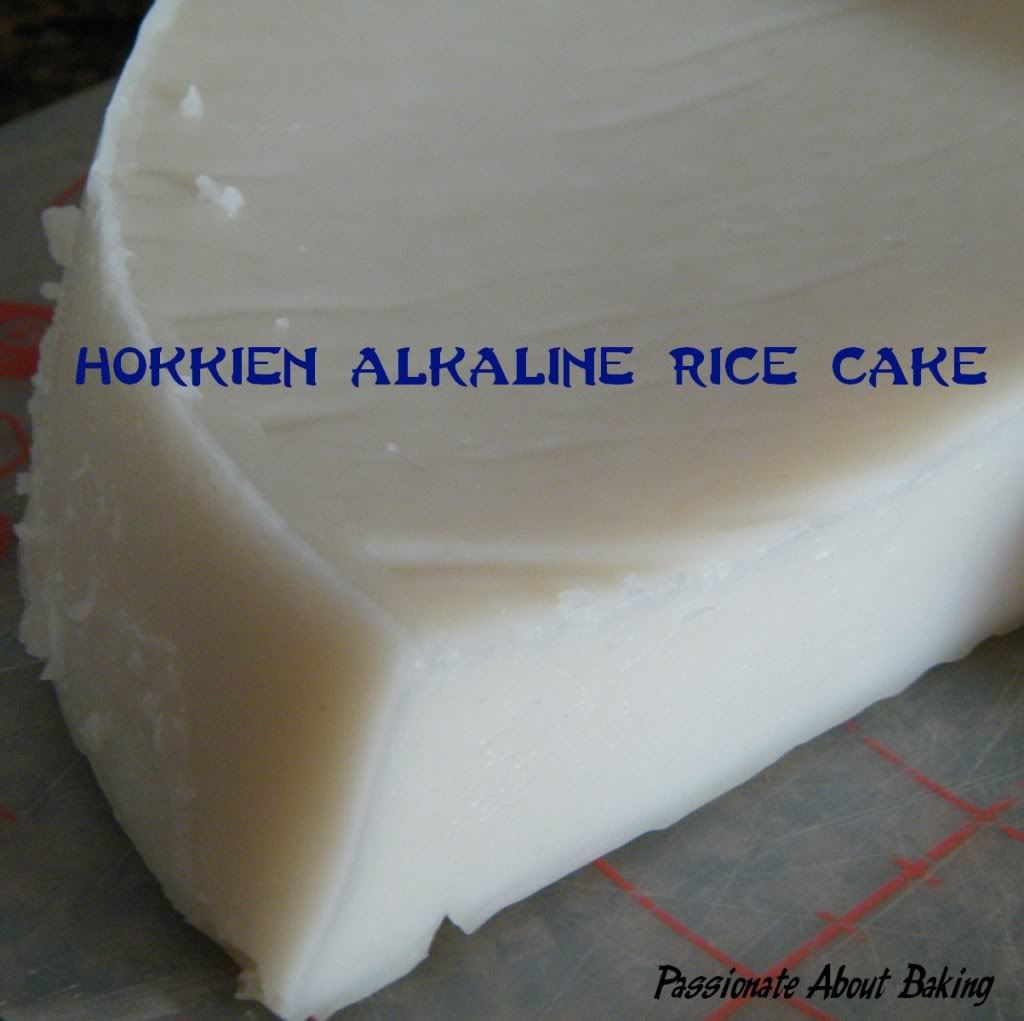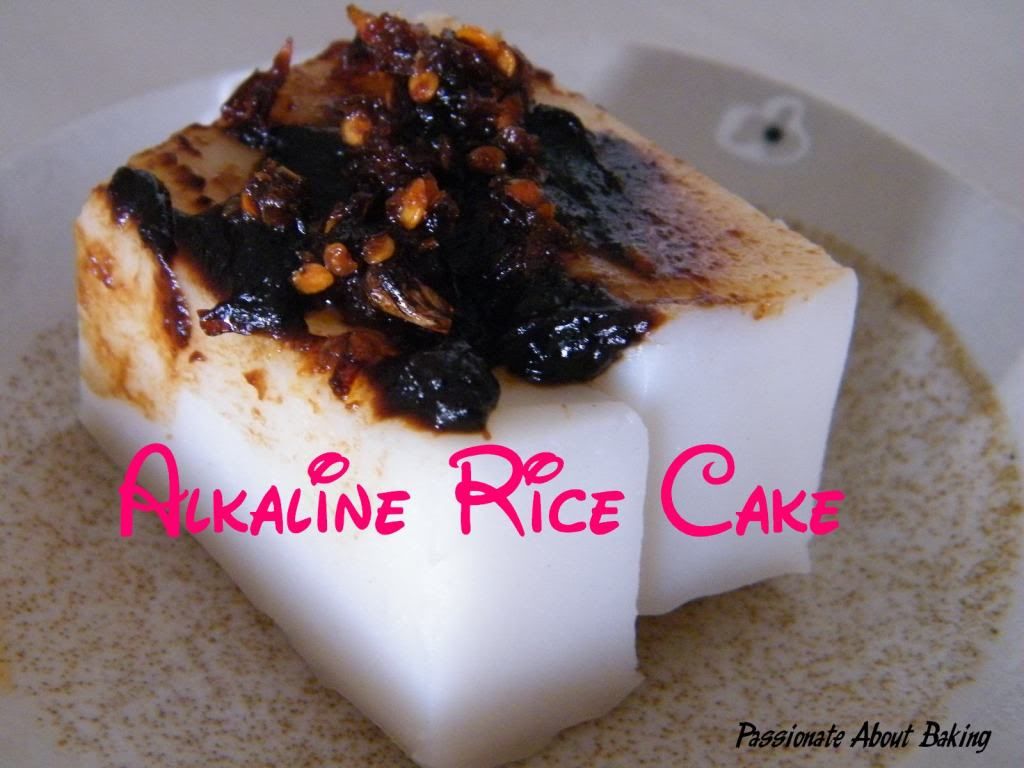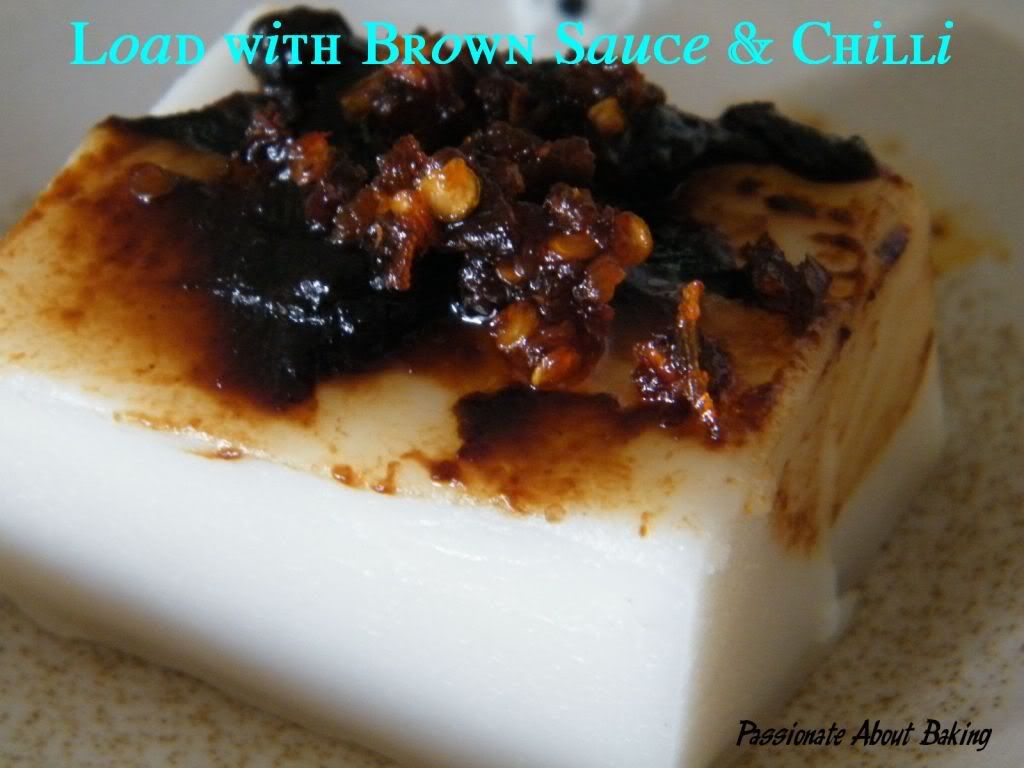As far as I know, both sides of my grandparents came from China. The Hokkien group which I belong to is known as "Ang Kui". Both of my parents are of Hokkien heritage too! When I married my husband, I learnt from my parents in law that they belonged to this same group too! However, when it comes to speaking Hokkien, I'm not as proficient as my husband. Many times, when my parents-in-laws and my spouse spoke Hokkien, I'll give them a blank look!
When I was younger, my parents spoke to us in Hokkien and Mandarin. Therefore, I didn't get to learn Hokkien dialect as much as I have to. It was just enough to converse with them and the elderly.
Hokkien dialect has a wide variety of foods, ranging from the most popular Hokkien Mee, Lor Mee, Prawn Rolls to Ang Ku Kuehs. As I didn't have the time to prepare these delicious Hokkien dishes, I decided on making Hokkien Alkaline Rice Cake instead.
I will be submitting this to Precious Moments' Heritage Food Trail.
Recipe for Hokkien Alkaline Rice Cake, extracted from "Delightful Snacks & Dim Sum" by Agnes Chang.
Makes a 9" pan.
Ingredients:
300g Rice flour
2 tbsp Corn flour
1200ml Water
1 tsp Alkaline Water
1 tsp Salt
2 tbsp Oil
Method:
- Mix rice flour, corn flour and water together in a saucepan. Stir well to mix.
- Add alkaline water, salt and oil. Stir well.
- Cook over medium heat until half cooked.
- Pour the batter into a greased 9" round steaming tray (or cake pan).
- Steam on high heat for about 45mins until cooked.
- Leave to cool completely before serving.
- Best to serve with stewed meat gravy. Or served with any other salty sauce.
Note:
- For step #1 above, you may strained the mixture if you like. I strained and found that the step was unnecessary.
- The rice cake is very soft when it's cooked. After it has cooled down, it will become tougher. So do not over-steamed, 45mins will be more than enough.
- The rice cake on its own taste terrible! It must be eaten with savoury gravy. I had mine with the "Yong Tau Foo" brown sauce and HK "chilli oil" and it was very tasty.
- You can served this chilled alkaline rice cake with gula melaka syrup as a nice sweet temptation.
Do join us for this Heritage Food Trail. I hope to learn more about other dialect groups and races too!





39 comments:
Hi-5! I'm Ang Kui too! But I Learnt to speak 'Nam Muar" from maternal grandparent!
That is what we called 'kee ah kueh' n we dip in all kind of sauce available.. Normally curry cos such delicacy are only available when we pray!
The rice cake itself is QQ n slight salty taste, pan fry it to gv a crispy crust is our all time favorite for breakfast :)
Fiona
I think I probably know more Hokkien or Cantonese dishes than my own Hainanese dishes...:) This is one kueh that is normally sold with Chee Cheong Fun? I haven't eaten this for a long time....
Jane, I saw this in that book too but I was already wondering which dialect dishes is this. Now I know.
Ai yo, this one is my FIL's most favourite kueh...would only seem right that I learn how to make it horr? Yup, I'm a true blue Hokkien too! High five on that! but same-o same-o here, I only good at eating and have half the clue which food exactly is our dialect group heritage food, lol!
My Hokkien neighbour makes this and eats it with palm sugar syrup cooked with coconut milk. It was very tasty. My neighbour is born in China and only came to Malaysia in her teens
Hi five! We belong to the same clan! Heehee... Actually I've never eaten this made from my elderly before. I didn't even know this is a Hokkien food! Oh, sure sounds good to pan fry it. But what do you add to let it taste good? Because on its own, it really taste bland! I think it will taste fantastically good with curry!!
Shirley, why I'm not surprised! Hokkien and Cantonese dishes seems to be all over and very common. Unlike Hainanese, it "seemed" to be more reserved. But I know Hainanese can cook very very well! I only know chicken rice and Yong Tau Foo originated from Hainanese dialect. :)
Yes, I think this is usually sold with chee cheong fun, so that they can share the same sauce. There is a stall in Telok Blangah market, which sold this together with pumpkin kueh and yam kueh. Yummy!
I miss this rice cake, when we were young, our mom used to make this for us. I must give this a try...thanks for sharing:)
Edith,
I also don't know Hokkien has this kueh! I saw it in the recipe and thought if it is termed "Hokkien", then it has to be Hokkien food. Heehee...Thanks for organising this Heritage food trail. Otherwise, I don't even know Hokkien dialect has this dish!
Hi five!! Heehee... "ka ki lang"! Hey, you must learn to make this, it's easier than any other kueh. If you make this well, your FIL will dote you more! Hahaha...
Thanks Wendy for the tips. I think it was what was suggested in the book too! Eating this way is likely to be desserts than savoury. I like savoury more. :)
Jeannie, so does that make you a Hokkien too? :p You should ask your mum for the recipe. I always believe in our parents' generation, they stuff that they make are "by gut feel". Such estimation is much better than those in cookbooks! Do you agree?
then in that case, I remember eating this with braised pork belly in a Hokkien restaurant
I tot yongtofu is Hakka?
I think there are variations. I thought it was originated from Hainanese? Hmm... wonder if anyone can confirmed this...
Then you are very right! Because the cookbook also mentioned to eat this with stewed pork!
Sorry Jane, I've never eat this before :( Wonder where can I look for this?
Hi Ann,
I only know a stall in telok blangah market that sells this. According to what Shirley said, it's usually sold with Chee Cheong Fun or kuehs.
I am Hokkien too and my ancestors are from Ang kui too. My grandma and mother will make a big tray of this kueh during festive season to eat it with Tau Eu Bak.
Thanks for the information gertrude! As a Hokkien, I didn't even know this was a popular dish with Tau Eu Bak! :p
This is my favorite and my mom who is Hokkien is good at this too. I like to eat mine with Sin Sin garlic chilli sauce :)
Thanks for the information Agnes! Is your recipe different from the cookbook? I always believe mom's or grandmom's recipes are the best!! :)
Hi, I am new here and I am also a Hokien. Please advise me how do I go about joining the group.
Hi Catherine, Welcome. There is no joining. You just see what other bloggers are submitting their bakes, you just follow.
Thank you. I love all hokkien traditional dishes and cakes, especially steam cakes, savory or sweet. I am searching for a recipe that calls for steam dark brown sugar cake. I like it but could not find the recipe.
Hi Agnes, you mentioned in the above recipe to cook the mixture till half cook, and would like to know what consistency? Will it be translucent and sticky or what should I look out for. Please advise, thank you.
thanks for the recipe, where could i buy alkaline water?
Hi Hui Fen,
You can buy from Phoon Huat if you are residing in Singapore.
thanks for the info!!!
How to make alkaline water or where to get
Hi Anne,
I bought the water from my local baking supplier shop. If you are residing in Singapore, you can buy from Phoon Huat.
Hi, By corn flour, do you mean corn starch or actual corn flour as in masa harina? I found your recipe for hokkien alkaline rice cake while searching for a recipe to make a taro treat I had at a friend's (who was not able to get her mother-in-law's recipe). The pudding base looked the same, but had chunks of taro and savory meat, like wu tao goh but not a homogeneous mixture. Thanks, Dana
Hi Dana,
The cornflour is the corn starch that you have mentioned, not the actual yellowish corn flour. Hope you it's similar to the taste you have been looking for.
I have tried twice on this but still not able to get the 'qq' texture. How then can i have this texture???
Hi. I'm not Hokkien but I was born in Penang so I can speak hokkien very well. When I was young, we used to have a shop care taker who retired and started selling this type of kueh. But he didn't pair it with sauces. Instead he sliced it thin and used it instead of kueh teow in a clear chicken broth just like kueh teow thng. I used to love eating it and would buy it from him everyday for breakfast. Good old days.
Maybe try adding more lye water or if you don't want the taste of lye to be too strong, maybe you can use tapioca starch instead of cornstarch.
Guess I am 10 years behind time. I am also of Ang Kui ancestry. Grandfather and grandma from China. Good to have found this recipe . I grew up eating this. I am hoping for more Hokkien dishes particularly from Ang Kui.
Guess I am 10 years behind time. I am also of Ang Kui ancestry. Grandfather and grandma from China. Good to have found this recipe . I grew up eating this. I am hoping for more Hokkien dishes particularly from Ang Kui.
Wow. Never realised that there are still so many old hokien folks knowing how to eat kee ah kueh. Normally I will cut it into small pieces like chai tow kueh and fry with eggs, mushroom, sausage and garnish with spring onion and fried onion. With chilli sambal it's a delicious delicacy. Have you also eaten hokien wah kueh? This is even better than kee ah kueh. This heritage dish is disappearing soon as only a few hawkers are selling it.
Post a Comment
Be free with your mind!